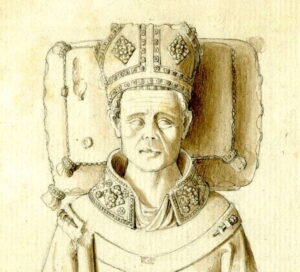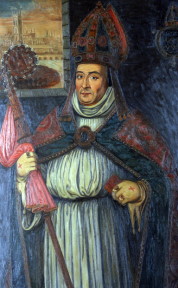The Clergy
You will have to forgive me here as I have lumped all the religious leaders together.
John Stafford – Archbishop of Canterbury
 Childhood
Childhood
John was born 1388 (approx.), the illegitimate son of Sir Humphrey Stafford of Southwick (Wiltshire). His mother was a local girl called Emma (surname uncertain). His ignominious start in life did not stop him from being successful.
Rise to Power
- Doctor of Cannon Law 1414
- Dean of Arches 1419
- Dean of Wells 1423
- Lord of the Privy Seal 1421-22
- Lord High Treasurer 1422-26
- Bishop of Bath & Wells 1425-43
- Lord Chancellor 1432-1450 – Resigned two days after Suffolk’s Banishment order.
- Archbishop of Canterbury 1443 – until death
 Character
Character
Although he politically aligned himself with the Duke of Suffolk, he does not seem to have provoked the wrath of the rebels. He was a very large land owner in Kent and was asked to be a member of the Commission of Oyer and Terminer due to that fact, and that he was a good mediator and judge. One commentator of the time said of him as, “If he had done little good, he done no harm”, which is probably why he was not on the “most wanted heads” list, of the rebels.
He wasn’t a “yes man” either, as shown by turning down the popes request for a tenth crusade, citing that the problems in France took precedence.
Like most people who reach high places he did attract criticism, one such person to criticise him was Thomas Gascoigne, who accused him of having an illegitimate child with a nun. Whether this salacious rumour was just malicious or true, we cannot tell.
William Waynflete – Bishop of Winchester
Childhood
William was born about 1398 in the town of his name, Wainfleet , Lincolnshire, a son of a merchant Richard Patten (Barbour) and Margery Brereton. Knowledge of his early life is sketchy and subject to debate.
Adulthood
He became a master and then head master at Winchester College in 1429 and held that position for 11 years. He was even visited by Henry VI in 1440, who admired Winchester College, he decided to replicate it at his new college at Eton. William was made Provost to Eton College.
Rise to Power
In 1447, William was made Bishop of Winchester. At the time of the rebellion, William along with Archbishop Stafford (and others) tried to negotiate with the rebels when they first arrived at Blackheath (to no avail). He also was present with the Archbishop in negotiations to give pardons to the rebels at St Margaret’s Church in Southwark.
 Although William was a supporter of Suffolk he too was not a target for the rebels, his residence, Winchester Palace near London Bridge and Southwark, was not not so lucky and was sacked during the rioting. William was not in residence whilst this happened.
Although William was a supporter of Suffolk he too was not a target for the rebels, his residence, Winchester Palace near London Bridge and Southwark, was not not so lucky and was sacked during the rioting. William was not in residence whilst this happened.
Aftermath
After the rebellion, William teamed up again with Archbishop Stafford in the Oyer and Terminer, to find the causes of the rebellion. It is possible, that the younger William had become Stafford’s right hand man (personal opinion). Williams career went on after the rebellion and he later became Lord Chancellor and managed to keep in the good graces of the Yorkist kings to come.
William Ayscough – Bishop of Salisbury
Rise to Power
William Ayscough (also Aiscough) was born about 1395, but not much is known about his early life. He became the. Kings chaplain and later became the Kings confessor (before 1440), giving him unbridled access to King Henry. In 1438 he became the Bishop of Salisbury. He rose so high as to officiate the English wedding of Henry and Margaret at Titchfield on April 22nd 1445.
Popularity
When Cade’s rebellion started he was named as one of the people they had grievances against, although I cannot pin point any particular incidents that he could be blamed for. Being the kings confessor and part of Suffolk’s clique may have been enough for him to be hated. He has been accused of advising the king to abstain from “sport” with the queen, linked to the death of Gloucester and being more interested in the King than his diocese. There may be some truth in these accusations but also they may well have been reported with Yorkist hindsight.
Unrest
Whatever the real reasons to why he was on the hit list of the rebels is unclear, but what is certain is that he felt threatened enough to leave London and head back Westwards. On June 19th the rebels insisted that William was arrested.
On 28th June, Williams baggage train which preceded him was intercepted and raided. The rebels got away with a large amount of silver, jewellery and £3,000 in cash. The Cade rebellion or at least the idea of rebellion had spread to the West.
Death
On 29th June, William was at Edington giving Mass for the Feast of St Peters & Paul, when a mass of people (up to 600) interrupted the service and forcefully removed him from the high alter to a nearby hill, stripped him naked and killed him.
Adam Moleyns – Bishop Of Chichester
Early Life
Adam Moleyns (Molynuex, Molins) was born about 1400 (which is just a guess) and took a career in Law within the church. He was obviously a boy who grew up to be a very able royal councillor.
Religious Career
The first real evidence of his career was in 1434 whilst working in the “papal curia” was representing King Henry. The position of Bishop of Worcester was to be decided and through constant lobbying by Moleyns, Pope Eugenius IV relented and allowed a young 22 year old, Thomas Bourchier, to take the position. There was no doubting Adam’s debating skills.
He became Dean of Salisbury in 1441 under Bishop Ayscough (see above) and later became Bishop of Chichester in 1445.
Royal Council
In 1436 Henry became a clerk of King Henrys council, for which he seemed ubiquitous. He became a full councillor in 1443, which coincides with the lack of attendance by other councillors. I expect that due to the lower attendance of council and the prevalent power of Suffolk, it is not surprising that he became an integral part of the Suffolk clique.
In 1444, Adam was given the role of keeper of the privy seal. Adam was in the team arranging the marriage of the King and the following peace treaty. In 1446, Adam very assured of his position within the council, openly besmirched the Duke of York’s Military ability, and accused him of peculation.
After the Battle of Sark 1448 (where I must say the English got a good spanking by the Scots – but that’s another story), Adam was one of the main negotiators to ensure the existing treaties were adhered to and to stop any further escalations.
Resignation
But when the political upheaval happened as a result of losing Maine, Adam was shrewd enough to see the writing on the wall and resigned his positions of office. His resignation was not immediate and he was asked to go to Portsmouth to give the first instalment of pay to the new army waiting there.
Death
There is some speculation as to what exactly happened next but most sources state there was an argument with the soldiers and sailors (approx. 300 strong) over money and he was pulled out of the Garrison church, Domus Dei, (or lodgings) and killed (I’ve seen reports of beheading, stoning, hanging, beating). There is probably some doubt over the assailants being just soldiers and sailors, as this murder the whole town of Portsmouth was excommunicated for 58 years, so local residents must have been included in the mob.
After his death the Duke of Suffolk tried to deflect some of the criticisms he received onto Adam by saying that he was the one who authorised the ceding of Le Mans.
